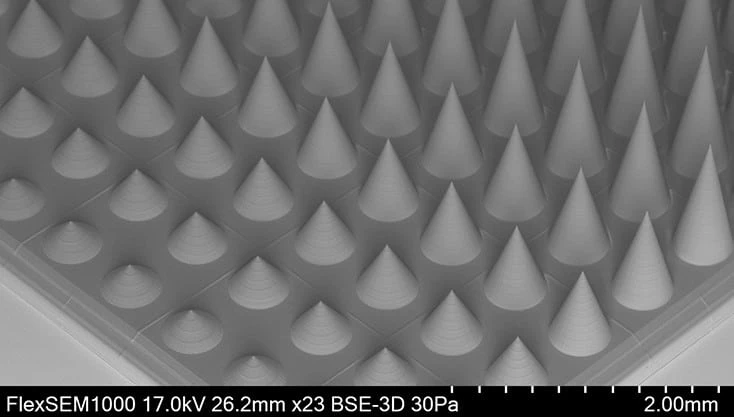
(Photo) An array of micro needles with an individual base diameter of 500µm and varying heights from 260µm to 2,000 µm was fabricated with a 10x objective using adaptive resolution. © UpNano GmbH
A 2PP 3D-printing system that is capable of manufacturing across 12 orders of magnitude with high speed enables fabrication of polymeric microparts from the nano to centimeter range. Several customers from industry and academia recently bought the NanoOne system by UpNano GmbH from Vienna (Austria), a spin-out of the TU Wien. The NanoOne has a high-power laser, an optimized optical pathway, a patented adaptive resolution technology, and purpose developed algorithms for laser scanning.
2-photon polymerization (2PP) 3D-printing is an ultra-precise production technology at the edge of the physically possible. It enables companies to manufacture parts that were, literally, unthinkable a few years ago.
New customer, new material
A European company specializing in optical applications was looking for a 2PP 3D-printing system that would be able to manufacture highly transparent components. The high-powered laser of the NanoOne not only allowed to deliver the necessary energy to polymerize this specific material, but UpNano also engaged a team of in-house specialists to develop the material in accordance with exact customer requirements.
Bernhard Küenburg, CEO of UpNano, comments on the successful cooperation and deal: "The NanoOne convinces with an innovative adaptive resolution technology that together with an optimized optical path and smart algorithms utilizes the full power of our exceptionally strong laser. All this allows us to add specific functionalities to the system that meet individual customer requests such as the ones of our industry partners."
Also, the University of Freiburg in Germany decided recently to purchase a NanoOne demonstrating the appeal of the device for industry and academia alike. The university will exploit the potential of the printing-system especially in the material sciences including guest particles that require a high versatility and adaptability of 3D-printing processes.
Another university in the D-A-CH-Region as well as in Scandinavia placed orders for a NanoOne system a few weeks ago, following competitive tender procedures. However, their motivation to opt for this system was mainly driven by financial constrains that are quite common in the academic domain. A more basic version of the NanoOne was able to meet those expectations as well as all technical specifications requested by the cutting-edge research groups for which these systems have been acquired.